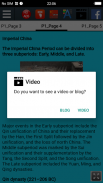








History of China

คำอธิบายของHistory of China
Written records of the history of China can be found from as early as 1500 BC[1][2] under the Shang dynasty (c. 1600–1046 BC).[3] Ancient historical texts such as the Records of the Grand Historian (ca. 100 BC) and the Bamboo Annals (before 296 BC) describe a Xia dynasty (c. 2070–1600 BC), which had no system of writing on a durable medium, before the Shang.[3][4] The Yellow River's Yellow river civilization is said to be the cradle of Chinese civilization, although cultures originated at various regional centers along both the Yellow River and the Yangtze River's Yangtze civilization millennia ago in the Neolithic era. With thousands of years of continuous history, China is one of the world's oldest civilizations,[5] and is regarded as one of the cradles of civilization.[6]
Much of Chinese culture, literature and philosophy further developed during the Zhou dynasty (1046–256 BC). The Zhou dynasty began to bow to external and internal pressures in the 8th century BC, and the kingdom eventually broke apart into smaller states, beginning in the Spring and Autumn period and reaching full expression in the Warring States period. This is one of multiple periods of failed statehood in Chinese history, the most recent being the Chinese Civil War that started in 1927.
Between eras of multiple kingdoms and warlordism, Chinese dynasties have ruled parts or all of China; in some eras control stretched as far as Xinjiang and Tibet, as at present. In 221 BC Qin Shi Huang united the various warring kingdoms and created for himself the title of "emperor" (huangdi) of the Qin dynasty, marking the beginning of imperial China. Successive dynasties developed bureaucratic systems that enabled the emperor to control vast territories directly. China's last dynasty was the Qing (1644–1912), which was replaced by the Republic of China in 1912, and in the mainland by the People's Republic of China in 1949, resulting in two de facto states claiming to be the legitimate government of all China.
เขียนบันทึกของประวัติศาสตร์ของประเทศจีนสามารถพบได้จากเป็นช่วงต้น พ.ศ. 1500 [1] [2] ภายใต้ราชวงศ์ซาง (ค. 1600-1046 BC). [3] ตำราโบราณทางประวัติศาสตร์เช่นบันทึกประวัติศาสตร์อันยิ่งใหญ่ (ประมาณ 100 ปีก่อนคริสตกาล) และไม้ไผ่พงศาวดาร (ก่อน 296 BC) อธิบายราชวงศ์เซี่ย (ค. 2070-1600 BC) ซึ่งไม่มีระบบการเขียนในสื่อคงทน ก่อนที่ชาง. [3] [4] แม่น้ำเหลืองของอารยธรรมแม่น้ำเหลืองจะกล่าวว่าเป็นแหล่งกำเนิดของอารยธรรมจีนแม้ว่าวัฒนธรรมเกิดขึ้นที่ศูนย์ภูมิภาคต่าง ๆ พร้อมทั้งแม่น้ำเหลืองและแม่น้ำแยงซีเกียงแม่น้ำแยงซีของอารยธรรมนับพันปีที่ผ่านมาในยุคหินใหม่ ที่มีมากมายของปีของประวัติศาสตร์อย่างต่อเนื่องจีนเป็นหนึ่งในอารยธรรมที่เก่าแก่ที่สุดของโลก [5] และได้รับการยกย่องว่าเป็นหนึ่งในเปลของอารยธรรม. [6]
มากของวัฒนธรรมจีนวรรณกรรมและปรัชญาการพัฒนาต่อไปในช่วงราชวงศ์โจว (1046-256 ปีก่อนคริสตกาล) ราชวงศ์โจวเริ่มที่จะยอมอ่อนข้อให้แรงกดดันภายนอกและภายในในศตวรรษที่ 8 และราชอาณาจักรในที่สุดก็แตกออกเป็นรัฐที่มีขนาดเล็กเริ่มต้นในฤดูใบไม้ผลิและฤดูใบไม้ร่วงรอบระยะเวลาและการแสดงออกถึงเต็มรูปแบบในช่วงรบสหรัฐฯ นี้เป็นหนึ่งในหลายช่วงเวลาของมลรัฐล้มเหลวในประวัติศาสตร์จีนที่ล่าสุดถูกสงครามกลางเมืองจีนที่เริ่มต้นในปี 1927
ระหว่างยุคของอาณาจักรหลายและ warlordism ราชวงศ์จีนได้ปกครองบางส่วนหรือทั้งหมดของประเทศจีน ในยุคบางควบคุมยืดเท่าที่ซินเจียงและทิเบตเช่นในปัจจุบัน ใน 221 BC จิ๋นซีฮ่องเต้สหราชอาณาจักรต่อสู้ต่างๆและสร้างขึ้นสำหรับตัวเองชื่อของ "จักรพรรดิ" (Huangdi) ของราชวงศ์ฉินลายจุดเริ่มต้นของจักรพรรดิจีน ราชวงศ์เนื่องการพัฒนาระบบราชการที่เปิดใช้งานจักรพรรดิในการควบคุมดินแดนกว้างใหญ่โดยตรง ราชวงศ์สุดท้ายของจีนเป็นชิง (1644-1912) ซึ่งถูกแทนที่ด้วยสาธารณรัฐประชาชนจีนในปี 1912 และในแผ่นดินใหญ่สาธารณรัฐประชาชนจีนในปี 1949 ซึ่งจะมีผลในสองพฤตินัยรัฐที่อ้างว่าเป็นรัฐบาลที่ถูกต้องตามกฎหมายทั้งหมด ประเทศจีน

























